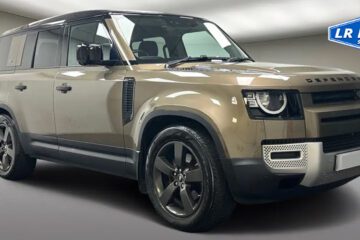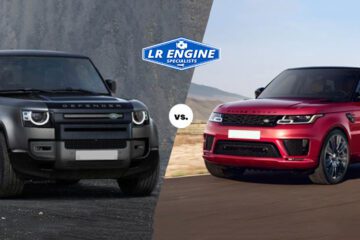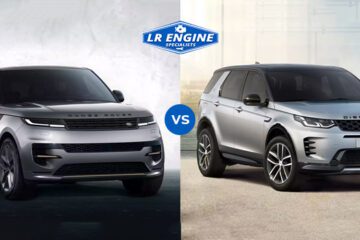The Land Rover Defender has earned iconic status for its unmatched off-road capabilities, powerful construction, and rich heritage as a true adventure vehicle. In its modern form, the Defender upholds that legacy while offering an excellent driving experience. But with innovation comes choice, and that’s where the Land Rover Defender engine comparison becomes necessary. Two outstanding options lead the pack: the efficient 2.0 D200 diesel and the more potent 3.0 Ingenium petrol and diesel variants. Each brings its distinctive strengths, designed for different driving styles and demands. Even if you prioritise fuel economy or want commanding performance, this engine lineup guarantees the Defender remains as versatile as ever, ready for anything the road or trail throws.
Introduction to Defender Engine Line-Up
Land Rover engine offerings have transformed to meet the demands of modern drivers, providing a blend of efficiency, power, and environmental responsibility. At the core of this transformation are the Ingenium engines, developed in-house by Jaguar Land Rover. These engines are designed to minimise emissions while maximising performance, a delicate balance that modern SUVS must maintain.
The Defender’s engine collection includes both petrol and diesel variants, designed according to different driving styles and use cases. The 2.0-litre D200 diesel engine sits at the base of the range, while the 3.0-litre Ingenium engines, provided in both diesel and petrol configurations, occupy the higher tiers.
Understanding the 2.0 D200 Diesel Engine
The 2.0 D200 diesel engine is part of Land Rover’s Ingenium family and works as the entry-level engine alternative for the Defender. This 2.0-litre, four-cylinder turbocharged diesel unit provides 200 horsepower and 430 Nm of torque, which is enough for daily driving and light off-road activities.
Fuel efficiency is a main strength of the D200. It returns an average of 32-36 mpg, based on driving conditions and vehicle load. This engine shines in urban settings and is well-suited for drivers who prioritise fuel economy over raw performance.
Despite its smaller displacement, the D200 is no slouch. It has mild hybrid technology (MHEV) in newer models, which boosts fuel economy and effortless output power delivery. However, when pushed hard, specifically with a fully loaded vehicle or during steep off-road climbs, the D200 can feel underpowered compared to its 3.0-litre rivals.
Exploring the 3.0 Ingenium Series
The 3.0 Ingenium engine comes in both petrol and diesel versions, offering a marked step up in performance from the D200. These six-cylinder engines are designed to provide a more refined, comfortable driving experience, specifically useful for long-distance travel, towing, and serious off-road adventures.
In the petrol version, the 3.0 Ingenium provides up to 400 horsepower and 550 Nm of torque. This variant is ideal for drivers wanting quick acceleration and dynamic handling. It can launch the Defender from 0 to 60 mph in just 6 seconds, numbers that rival some sports cars.
The 3.0 diesel Ingenium, meanwhile, offers a more balanced fusion of performance and efficiency. With outputs ranging from 250 to 300 horsepower and torque figures exceeding 600 Nm, the diesel variant is a towing and hauling champion. It is also packed with MHEV technology, improving its appeal to eco-conscious buyers.
The development of the 3.0 engines is evident in their quiet operation and effortless power delivery. Compared to the 2.0 D200, the 3.0 series feels impressively more premium and capable, both on highways and challenging terrains.
On-Road Performance Comparison
When it comes to on-road performance, the difference between the 2.0 D200 and 3.0 Ingenium engines is quite significant. The D200 is competent and reliable, but its acceleration and top-end performance are modest. It’s appropriate for urban environments and moderate-speed cruising.
The 3.0 Ingenium engines, by contrast, shine in on-road scenarios. Even if you’re overtaking on highways or navigating steep inclines, the additional power and torque are immediately apparent. The petrol version, specifically, offers a lively and engaging driving experience that changes the Defender into a true performance SUV.
Off-Road Capability Assessment
Off-roading is the main component of the Defender’s identity, and the engine you select can significantly influence your vehicle’s performance in the toughest terrains. While the 2.0 D200 tackles basic off-road tasks with ease, including mud, gravel, and shallow water crossings, it may struggle in tougher conditions.
The 3.0 Ingenium diesel and petrol engines are more competent in demanding environments. The extra torque, especially in the diesel version, enables easier hill climbs, better traction, and superior low-end grunt. These engines pair impressively well with Land Rover’s Terrain Response system, providing drivers with confidence on even the roughest trails.
Fuel Economy and Environmental Impact
In terms of fuel economy, the 2.0 D200 forefronts. Its compact size and MHEV combination yield better mileage, making it an ideal choice for budget-conscious drivers and those who regularly drive in cities.
The 3.0 Ingenium engines, while more potent, do consume more fuel. The petrol version is the least efficient, with actual mpg figures often falling below 25. However, both the petrol and diesel 3.0 engines benefit from MHEV systems, which somewhat lessen their fuel consumption.
From an environmental point of view, Land Rover has made notable strides. All Ingenium engines are compliant with the latest Euro 6d emissions standards, and future versions are expected to combine more electrification technologies. Still, the 2.0 D200 remains the greener option in the current range.
Maintenance and Ownership Costs
Another vital factor in this Land Rover Defender engine comparison is the cost of ownership. The 2.0 D200 is reasonable to maintain, due to its simpler engineering and lower fuel consumption. Parts are normally more affordable, and the engine is less prone to wear under normal usage.
Conversely, the 3.0 Ingenium engines have more complex systems, including turbocharging and MHEV integration, which can maximise maintenance costs. However, these engines often come with prolonged warranties and service packages, specifically when purchased from certified dealers.
The 3.0 models normally come with higher insurance costs, reflecting their improved performance capabilities. That said, many owners consider the extra cost worthwhile for the boosted driving experience.
Towing and Payload Capacity
Towing capability is the main consideration for many Defender buyers. Here, the 3.0 Ingenium engines dominate. With higher torque figures, they can tow up to 3,500 kg, making them appropriate for trailers, boats, and caravans.
The 2.0 D200, while capable, has a lower towing capacity and may work with heavier loads over long distances. If towing is a regular activity for you, the upgrade to a 3.0 engine is highly suggested.
Longevity and Resale Value
Long-term reliability is essential when investing in a high-end SUV like the Defender. Both engines are built for longevity, but the 3.0 Ingenium engines generally retain more value. Their higher performance and broader appeal in the used car market make them a better option from a resale perspective.
The D200 is reliable and durable, but may be seen as underpowered by future buyers, potentially lessening its resale value. However, for those who plan to keep their Defender for many years, this may not be a major concern.
Which Engine Is Right for You?
Ultimately, the option between the 2.0 D200 and 3.0 Ingenium series comes down to your specific demands. If you’re mainly driving in urban areas, value fuel economy, and want a lower-cost entry into the Defender range, the D200 is a perfect choice. It delivers respectable performance with exemplary efficiency.
However, if you decide to use your Defender for long-distance travel, heavy towing, or serious off-roading, the 3.0 Ingenium diesel or petrol variants offer significantly more power, refinement, and capability. The extra investment pays off in driving pleasure, versatility, and potential resale value.
Final Thoughts
Choosing the right engine is a vital step in the Defender ownership journey. This Land Rover Defender engine comparison highlights the main strengths and trade-offs of both the 2.0 D200 and 3.0 Ingenium petrol and diesel engines. Each has its place, and understanding your driving habits and plans will help you toward the perfect choice.
For expert advice, customised service, and premium upgrades, visit LR Engine Specialists, your go-to destination for all things Defender. Even if you’re looking for boosted performance or better fuel economy, our specialists can help you make an informed, confident decision.
FAQs:
Is the 3.0 Ingenium engine worth the extra cost?
Yes, if you want more power, towing capacity, and off-road capability, the 3.0 engine justifies the upgrade.
Which engine is more fuel-efficient?
The 2.0 D200 is more fuel-efficient, specifically in city driving and with light loads.
Is the D200 engine powerful enough for off-roading?
Yes, it tackles basic off-roading well, but it may struggle in tougher terrain or with heavy loads.
What’s better for towing—D200 or 3.0 Ingenium?
The 3.0 Ingenium (especially diesel) is superior for towing due to higher torque and capacity.
Do both engines have mild hybrid (MHEV) tech?
Yes, both include MHEV systems, helping enhance efficiency and effortless power delivery.


